ISSN ONLINE(2278-8875) PRINT (2320-3765)
ISSN ONLINE(2278-8875) PRINT (2320-3765)
N.Madhu1, G.Bhaskar Phani Ram2, J.Krishna Chaitanya2 and K.Harikrishna3
|
| Related article at Pubmed, Scholar Google |
Visit for more related articles at International Journal of Advanced Research in Electrical, Electronics and Instrumentation Engineering
This paper describes the Intelligent Energy and Power Management System (IEPMS) to manage power distribution and power consumption in home space. The thought of dynamic assignment of priorities for all the patron is delineate during this paper. Slicing of interrupt timings conjointly mentioned which might be wont to improve the performance and additionally we are able to show the Units of Power consumed and quantity on alphanumeric display and also we are able to send the quantity to the patron mobile mistreatment GSM module .The total system is dominant from home server and therefore the system has developed through ARM processor and wireless communication networks. in keeping with the management commands of the house server , the IEPM system may be controlled mechanically by dynamic the masses. The un- interrupted power provide of the patron is achieved through the projected design and it provides a lot of economical energy management.
Keywords |
| IEPMS, ARM Processor, Zigbee, Home server, GSM Module. |
INTRODUCTION |
| The implementation of these energy saving technologies needs meticulous measurement of consumptions, because effective measurement is equal to pompous performance of the coherent technologies. For this reason only the demand increasing form this energy and power measuring instruments. The growth of technology leads the usage power increased more in the home area [1]. Although advanced integrated circuit (IC) chipset and hardware technology magnifies the power efficiency of home appliances and consumer electronics, the current energy crisis and greenhouse effect require energy and power management in all areas [2-3]. |
| In this described system, we have designed an architecture of effective power management in the home section, which can be controlled by a home server. The home server is linked with the home section by means of Wireless sensor network (WSN).Wireless sensor network is instituted of a large amount of miniatures self-organizing wireless sensor nodes. By collaborating three kinds of technology such as electronics, sensors and wireless communication, Wireless Sensing Network detects, collects and deals with the object information in its covering area, and sends data to the home server [3]. In a word, WSN technology has the advantages of coverage of wide areas, allowed to remote monitoring, high monitoring accuracy, fast network establishments and it comes under a reasonable cost. |
| In this paper, we bring forward more efficient IEPMS based on ZigBee communication and ARM processor. To implement the automatic standby power cut-off outlet with power measurement functions. The home server is designed to collect the information about the control section and at the same time the consumed power will be displayed in the control section itself. In this architecture, we proposed a clear management system, which is having a priority based control system. This is nothing but, when the server sends the command signal then the unit will go to the particular priority mode. So that wastage of power will be prevented. |
RELATED WORK |
| Totaling 100 households. The homes with the feedback installed saved an average of 12.9% over the control groups (Dobson 1992). Since our system also uses computer monitors to display feedback data, we could potentially expect similar results. Several principles must come into consideration when developing a useful energy feedback system. One study of eighty residential electricity consumers found that those asked to achieve a difficult goal of 20% energy use reduction saved significantly more than those asked to achieve an easy goal of 2% energy use reduction (Becker 1978). So, a feedback system should integrate an element of challenge for the users to maintain interest levels and to achieve the best possible performance. The designers of the system should be careful, however, not to assign impossible tasks to consumers that would merely lead to those users ignoring the system. Another strategy that can be quite effective is using competition among a set of peers. A basis for this strategy is found in the theory of social norms, which capitalize on the tendency of human beings to move towards behaviour they perceive as normal. In a 2007 study, two types of normative feedback were used among 290 residences. |
| After a baseline period, the first half received handwritten feedback indicating how much energy had been consumed above or below the neighbourhood average during a billing period. This feedback resulted in a predictable boomerang effect in which behaviour change largely depended on whether or not users were already consuming above or below the average (the smaller consumers actually ended up using more energy). For the second half of users, a smiling or frowning face was also hand-drawn on the note according to whether consumption was below or above average, respectively. This injunctive message of positive or negative emotion effectively eliminated the boomerang effect, causing the lower consumers to continue saving energy as before (Schultz et al 2007). Integrating the lessons of previous user feedback studies into our electricity metering system is essential, as the primary objective of the system is to maximize the positive behaviour change of our users. Additionally, our current and future versions of the wireless metering system should draw on the lessons learned from the commercial metering industry over the past century. |
| Although electricity meters have historically been analog, converting the incoming data to a digital signal can greatly enhance the accuracy and flexibility of the measurement. Accurate analog metering is further made difficult by multiplier drift and variation over long periods of time (Johnston et al. 1978). Furthermore, electronic electricity meters that utilize analog-to-digital converters as well as voltage and current sensors can achieve a high measure of accuracy. Microcontrollers on board the circuit can control and standardize the output so that very little in terms of scaling and calibration is necessitated after production (Edge et al. 1998). The wireless mesh networking could be handled by a range of various platforms, but the ZigBee (802.15.4) protocol is the most convenient for quick and efficient production. The protocol is used by many manufacturers to design mesh network transceivers, and it is being used more and more often within the world of sensor technologies (Hill et al. 2004). Although combining all of the desired technical features into the first iteration of the meter |
| The subject of Embedded Measurement Systems (EMS) is the merging of embedded systems and electrical measurement systems. This indicates that EMSs are hardware-software systems dedicated to measuring one or a few physical quantities. Applications are numerous; EMSs measure the temperature in refrigerators, freezers, irons, ovens and automobile combustion engines, they sense vibrations in tilt alarms and game consoles, they measure airflow in engines and ventilation systems, they measure shock impact in crash detectors and are used as shock and temperature loggers for transport goods, they measure air pressure in airplane cabins, humidity in air-conditioned environments, they measure liquid levels in fuel tanks, they detect smoke in fire alarms, they measure the viscosity of lubricant oil in engines, they measure the rotation speed of spinning wheels (in any engine), they measure torque in engines and are used as heart rate and ECG detectors in medicine etc. |
| The commercial demand for ever cheaper products and worldwide environmental legislations force vendors to continuously look for more cost-efficient and less power-consuming solutions for their embedded measurement systems. This thesis is concerned most of all with the implementation of cost efficient low-power measurement systems in embedded controllers. This includes some novel ideas in voltage, time and resistance measurements with embedded controllers and it will demonstrate how these quantities, analog in nature, can be measured accurately and precisely by inherently digital embedded controllers. |
PROPOSED IEPMS ARCHITECTURE |
| The Fig. 1 describes the architecture of the proposed IEPMS Architecture. The proposed architecture uses an ARM processor as a core and the power management priority settings will be programmed. Current transformer and the potential transformer will calculate the power factor and it will be given to the processor continuously. These information will be processed by the processor and it will calculate the amount for that consumed power. For easy understanding this information will be display on the device itself. |
| This unit will also have a priority based load sharing in order to manage the power usage. This priority level will be turned on or turned off according to the interrupts generated by the home server section. So that an automatic power consumption method will be implemented in the home section [4-8].The IEPMS is connected to the wireless communication section. Here, Zigbee is used as a network technology. Zigbee is a transceiver it can be attached to the processor section and to the home server section. |
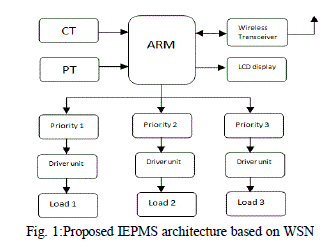 |
| The home server section is shown on Figure2. In this part, the Zigbee, GSM are interfaced on a server. ZigBee will collect the continuous data onto the IEPMS. The amount level will also be displayed on the server part and also sending amount levels, Due date as message to the consumer [9-11]. |
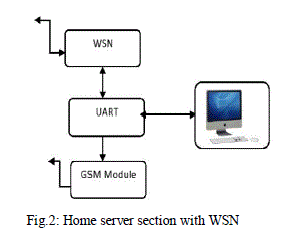 |
| So that a user can know the amount level and due date. When a control signal is generated, this information will be sent to the processor. Then the processor will check the interrupt and then according to the program the particular priority setup will be activated in the home section. This will avoid unwanted power usage in home sections. |
IMPLENTATION AND RESULTS |
| This system uses ARM processor as a core and wireless sensor network communication as a transmission medium for the data transfer. This IEPMS consists of two important sections. One is IEPMS device section and the other one is Home server. These two devices will be interlinked with the help of Zigbee wireless communications. The processor will be connected to the CT and PT which in turns separate the voltage level and current level to the processor. According to the written program the processor will calculate the power factor and its corresponding amount will be displayed on the device. An interrupted based priority control is introduced in order to achieve the effective home lighting with power saving. Through the WSN, the consumption detail will be sent to the home server section. In the home server section, every option will be available. So, according to the use selection, a unique will be sent to the processor core via. Zigbee communication. |
| The processor receives that signals and check with the program and then automatically, the corresponding priority levels will come to activation which in turns control the power consumption. |
A. Design Flow Chart |
| The flow chart of the IEPMS is shown below with all the functional blocks. The step by step working of the hardware is given in the functional blocks. After getting start the system initializes the input and out put values and calculates the V and I values individually and power factor is calculated according to the formula P = V.I and it checks for interrupt if any is available and if available it checks the priority if that and changes the load according to that. |
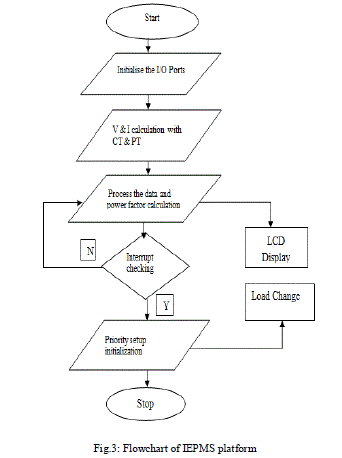 |
B. VB platform |
| In this system we are using a home server section to monitor the power consumption to control the lighting system on the priority basis. This output will be displayed on the computer screen using visual basic software.The figure shows the IEPMS monitor and control section. The controlling person can monitor the current power consumption at the same time according to the requirement we can control the lighting system. |
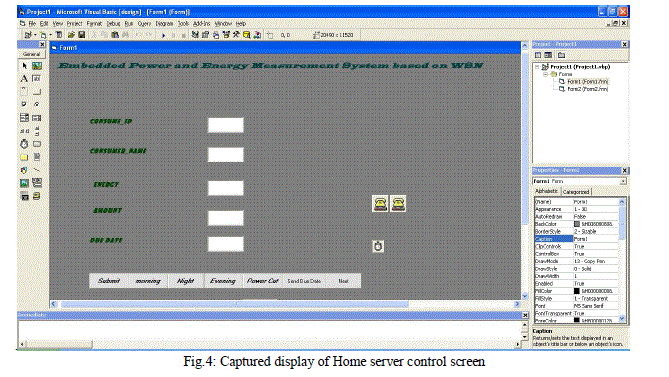 |
| The home server display window has the feasibility to show the amount and energy consumption [12]. The hardware system will calculate the power factor of values coming from CT and PT. Then according to the program the amount will be calculated and displayed on the LCD. Through UART communication this data will transfer to PC as shown in the Fig. 5(a).The amount value is sending to consumer from home server using GSM Modem which is shown in the Fig. 5(b). |
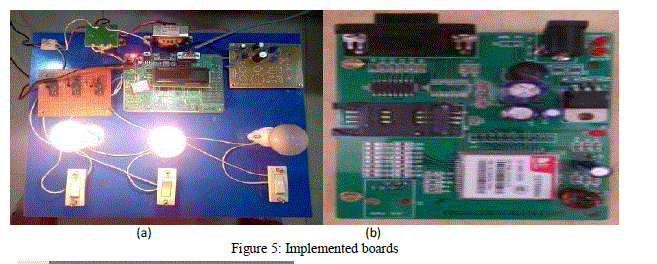 |
| These types of data display will be useful for all class as users. In that screen itself different options will be available. |
| According to the inputs different commands were generated and it was transferred to the ARM Processor through the UART communication. The processor had been comparing these interrupt commands of the program and it had been doing the predefined operation of changing the loads. From this total operation we can control the power consumption and we can achieve the uninterrupted power supply to the consumer by checking the power storage available for the home server. If storage is insufficient we have to select priority 1, in this priority the load is connected to essential needs of consumer like one bulb, one fan etc.. If the storage is average we are selecting priority 2, in this the load is connected to bulbs, fans, cooker etc.. If the enough storage is available for the home server selecting priority 3, in this the load is connected to all the electric appliances. |
CONCLUSION |
| Power consumption is an essential need in the day to day life. In order to make the power saving IEPMS is playing an effective role to bring the power wastage factor in control. In this system, display section is kept in the device in a visible manner. At the same time the controlling person also can see the energy and amount value through the home server. Then according to the requirements the control commands will be passed to the IEPMS device which will turn on or off the load with respect to the priority. Thus the power can be managed in an efficient way. |
References |
|